Elevate Your Home: Luxury Designer Bathrooms
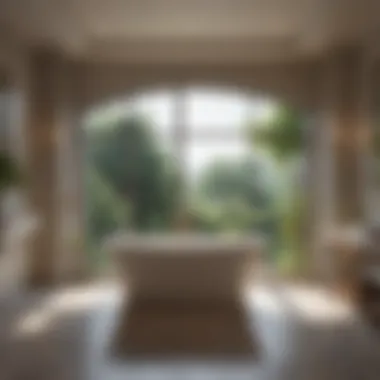
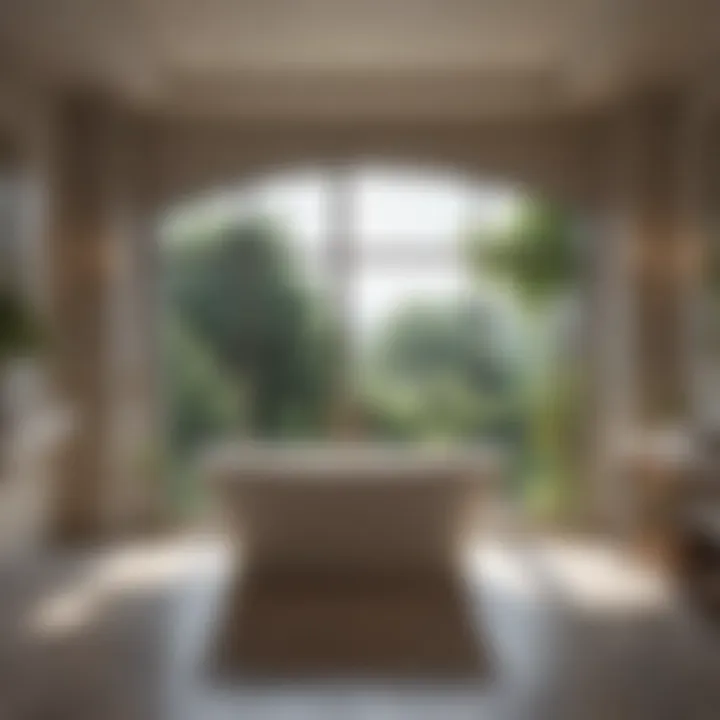
Intro
In the realm of home improvement, the bathroom stands as a crucial space. Luxury designer bathrooms not only reflect personal style but also serve as a sanctuary for relaxation and rejuvenation. This article aims to examine the various elements that transform ordinary bathrooms into opulent retreats.
We will explore design principles that enhance both aesthetics and functional aspects. From essential features to the materials that make a lasting impact, the discussion will provide insights for homeowners and design enthusiasts alike. Attention will be given to the current trends that inform luxurious bathroom designs while catering to the needs of modern living.
We begin with interior design tips to help you conceptualize your ideal bathroom.
Interior Design Tips
Creating a luxury bathroom requires careful planning and design foresight. Here are key factors to consider:
Trendy Design Ideas
- Freestanding Bathtubs: These serve as statement pieces, offering relaxation alongside aesthetic appeal.
- Walk-in Showers: Spacious and sleek, these should feature rain showerheads and multiple jets for a spa-like experience.
- Dual Vanities: Ideal for couples, they enhance usability while adding to the elegance of the space.
Color Schemes and Combinations
Selecting the right colors is paramount. Neutral palettes such as soft grays, creams, and whites promote calmness. However, splashes of deep blues or greens can introduce sophistication when paired with gold or matte black fixtures. Consider these combinations:
- Soft Grey & White: Timeless elegance.
- Deep Navy & Gold: Modern luxury.
- Earthy Tones: Create warm, inviting spaces.
Furniture Arrangement Techniques
Optimizing layout is essential in luxury bathrooms. Position fixtures to maximize space and ensure functionality. A few tips include:
- Place the bathtub near a window to enhance natural light.
- Ensure pathways are clear for easy movement.
- Group seating areas, like chaise lounges, to create a relaxing nook.
Tip: Always contemplate the functionality of each section before executing the design.
Essential Features
A luxury bathroom is defined by its features. Incorporate items such as:
- High-quality faucets and fixtures
- Underfloor heating for comfort
- Custom cabinetry for storage
- Luxurious towels and robes as finishing touches.
The climax of this exploration lies in understanding how these elements work together to forge an environment of relaxation and elegance.
Ending
In a constantly evolving design landscape, luxury bathrooms continue to push boundaries in both form and function. By focusing on curated design principles, essential elements, and innovative features, homeowners can create personal spaces that resonate with their unique tastes and lifestyles. As we transition to examining trends that shape luxury bathrooms, we’ll gain further insight into crafting a space that merges practicality with indulgence.
The Concept of Luxury in Bathroom Design
The concept of luxury in bathroom design embodies more than just exquisite materials and high-end finishes. It is about creating an experience that elevates the mundane act of self-care into a retreat. A luxury bathroom serves as both a practical space and a serene sanctuary. In this section, we will explore the complexity and significance of luxury within bathroom environments.
Defining Luxury in Interiors
When we define luxury in interiors, it often refers to an appealing and thoughtful blend of comfort, exclusivity, and aesthetics. Luxury reveals itself through meticulously selected materials, attention to detail, and a cohesive design that addresses both functionality and visual pleasure. Natural materials such as marble or granite create an enduring sense of quality.
Furthermore, luxury is marked by personal touches, which add warmth and character to the space. These may include artisanal elements that reflect the homeowner's individuality. Each choice, from the color palette to the choice of fixtures, contributes to a greater narrative that defines the living experience.
Key Characteristics of Luxury Bathrooms
Several characteristics distinguish luxury bathrooms from their standard counterparts. Understanding these key features can assist in both conceptualization and execution.
- Opulence: High-end materials, such as premium stone or custom cabinetry, create a sumptuous atmosphere.
- Spatial Planning: Luxury bathrooms often incorporate spacious layouts. They feature walk-in showers or soaking tubs that promote comfort and relaxation.
- Technology Integration: Modern luxury is incomplete without the integration of advanced technology. Innovations such as smart toilets, heated floors, and ambient lighting systems add convenience and enhance the overall experience.
- Customized Solutions: Tailored units, such as vanities and storage, provide both utility and elegance. Bespoke designs cater to individual needs while maintaining aesthetic harmony.
- Artistic Accents: Incorporating art and unique accessories can transform the bathroom into a personal gallery.
"True luxury is about the experience, not just the cost of materials."
Indeed, creating a luxury bathroom involves a balance of these characteristics. Overall, understanding the concept of luxury in bathroom design helps homeowners envision spaces that go beyond mere functionality and embody a lifestyle choice.
Essential Features of Designer Bathrooms
The demand for luxury designer bathrooms continues to rise, reflecting broader lifestyle aspirations. Homeowners no longer view a bathroom merely as a utilitarian space; it has evolved into a sanctuary of comfort and style. Therefore, understanding the essential features of designer bathrooms is crucial to creating an environment that balances both aesthetics and functionality.
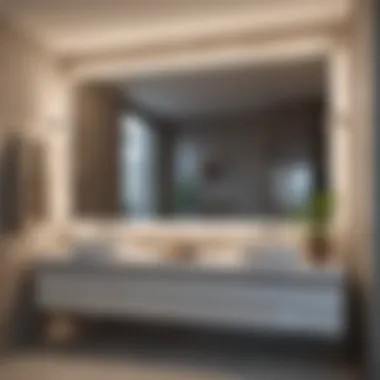
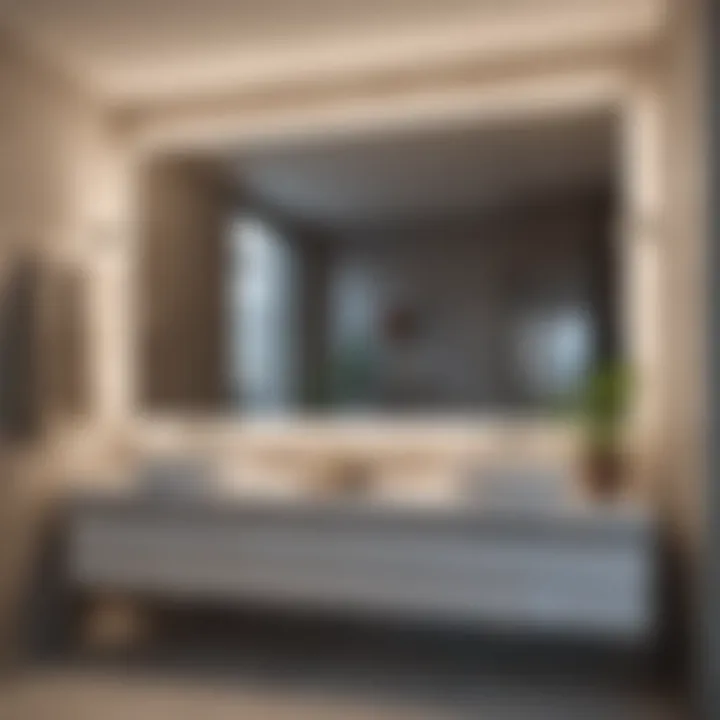
Custom Vanities and Storage Solutions
In luxury bathrooms, custom vanities offer more than just storage. They bring personalization to the space. A well-designed vanity can highlight the overall style of the bathroom. Whether it’s a contemporary piece with clean lines or a classic model featuring ornate detailing, each choice speaks volumes about the homeowner's taste.
Additionally, effective storage solutions are vital for maintaining a streamlined appearance. This includes options like open shelving, concealed cabinets, and even integrated drawers. These thoughtful features enable easy access to daily essentials while keeping clutter at bay. Consider using materials that match the overall decor to enhance cohesion and style.
High-Quality Fixtures and Fittings
Quality fixtures are the backbone of a designer bathroom. High-end faucets, showerheads, and bathtubs not only enhance the visual appeal but also assure longevity and resilience. Materials such as brass, stainless steel, and ceramic offer durability and aesthetic charm.
Moreover, design is equally important; modern fixtures come in various styles, from minimalist to extravagant. Choosing the right fixtures can elevate the space significantly. It is imperative to strike a balance between style and functionality, ensuring that practical use is not sacrificed for appearance.
State-of-the-Art Technology
Technology integration is a hallmark of designer bathrooms. Smart features such as heated floors, automated lighting, and advanced water systems offer conveniences that redefine luxury.
For instance, digital shower controls provide precise temperature regulation and water flow customization. Similarly, smart mirrors equipped with touch controls and lighting enhance both functionality and style. Incorporating these features not only modernizes the space but also promotes efficiency and comfort.
Material Choices for Luxury Bathrooms
In the realm of luxury bathroom design, the choice of materials is paramount. Higher-end bathrooms are not just about aesthetics; they also bring together function and sensory experience. When selecting materials, considerations must include durability, maintenance, and how they interact with design elements. A well-chosen material can enhance the ambience, evoke comfort, and showcase personal style. For homeowners and design enthusiasts alike, understanding material choices can lead to transformative environments that elevate everyday routines into indulgent experiences.
Natural Stone and Tile
Natural stone and tile remain quintessential options in luxury bathrooms. Materials like marble, granite, and travertine are prized for their beauty and uniqueness. Each slab has distinct patterns and colors, ensuring that your space won’t feel manufactured or replicated. These stones are not just visually appealing; they also provide a sense of permanence and grandeur.
Beyond aesthetics, natural stone surfaces are exceptionally durable and resistant to heat and chemicals. Marble, for instance, can create elegant vanities and stunning shower walls. However, maintenance is an important consideration. Natural stones may require sealing to prevent stains and water damage. Homeowners need to weigh the upkeep against the beauty these materials offer.
Innovative Surfaces and Textures
With advancements in technology, innovative surfaces are becoming more prominent in luxury bathroom design. Materials such as porcelain slabs and engineered quartz provide vast design possibilities while maintaining functionality. They offer a sleek finish that can mimic natural stone or provide a uniform look across the entire space.
Textures play a significant role in enhancing the sensory experience. Textured tiles can add depth and interest, creating a tactile environment that goes beyond mere visual appeal. For example, a matte finish or embossed tiles can instill a warm, comfortable feel that smooth surfaces may lack. Designers and homeowners should also consider integrating these surfaces in unexpected areas, such as vanities or accent walls, to further enhance the design narrative.
Eco-friendly and Sustainable Options
Sustainability is increasingly important in luxury bathroom design. Eco-friendly materials not only minimize environmental impact but can also add a unique charm to the space. Recycled glass tiles, bamboo vanities, and low VOC coatings are prime examples of materials that marry luxury with responsibility.
Choosing sustainable materials often leads to innovative designs that emphasize natural beauty. For instance, reclaimed wood vanities can provide a rustic yet refined focal point. Moreover, using materials sourced from local suppliers can support the community and reduce carbon footprints. Homeowners who select eco-friendly options often enjoy the added value of contributing to sustainability while achieving a sophisticated aesthetic.
"Incorporating eco-friendly materials in bathrooms not only nourishes the environment but can also create stunning design elements that reflect conscientious luxury."
Ultimately, the choice of materials in luxury bathrooms can either enhance or detract from the overall design philosophy. Homeowners must carefully consider their selections to ensure they align with their vision and lifestyle. Every choice in material—from natural stone to innovative surfaces and sustainable options—contributes to a luxurious, desirable space.
Color Schemes and Lighting in Designer Bathrooms
Color schemes and lighting are pivotal in the design of luxury bathrooms. They influence the overall feel and functionality of the space. A coordinated color palette evokes a sense of tranquility and harmony, while the right lighting enhances the room's aesthetics and utility. Choosing the right colors and lights can transform a simple bathroom into an indulgent retreat.
Choosing a Cohesive Color Palette
Selecting a cohesive color palette is crucial for establishing a unified look within the bathroom. A consistent color theme ties together various components, such as fixtures, tiles, and cabinetry. When picking colors, consider the size and natural light available in the space. Light colors, such as soft whites or pastels, can make smaller bathrooms appear larger. Conversely, darker hues can add drama and sophistication.
- Monochromatic schemes tend to be the safest option, allowing for layering of different shades of a single color. This approach creates a subtle yet elegant effect.
- Analogous colors, which are adjacent on the color wheel, can create a serene and calming atmosphere. Combining greens with blues or browns with tans can evoke a natural feel.
- For those looking for a bolder approach, complementary colors can provide a striking contrast, making elements stand out beautifully. However, this requires careful balancing to avoid overwhelming the space.
Lighting Layers and Ambiance
Lighting should be designed with layers to enhance the bathroom's ambiance and functionality. Consider a combination of ambient, task, and accent lighting. Ambient lighting provides overall illumination, while task lighting focuses on specific areas like the vanity or shower space.
- Recessed lighting can efficiently blend into the ceiling, offering strong background light without stealing focus from other design elements.
- Vanity lights should be strategically placed to ensure even lighting on the face, reducing shadows during grooming tasks.
- Adding decorative fixtures, such as chandeliers or pendant lights, can also elevate the design. These elements serve as focal points while contributing to the stylish atmosphere.
"Proper lighting can reflect the quality of materials used in the space while creating an inviting ambiance."
Trends in Luxury Bathroom Design
Keeping up with trends in luxury bathroom design is crucial for homeowners and interior designers alike. These trends not only reflect contemporary aesthetics but also respond to evolving lifestyle needs. Modern luxury bathrooms integrate comfort, style, and functionality. This section explores various trends that shape high-end bathroom spaces today.
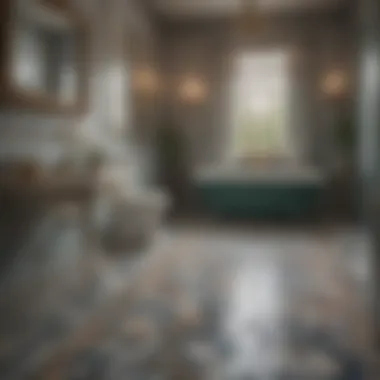
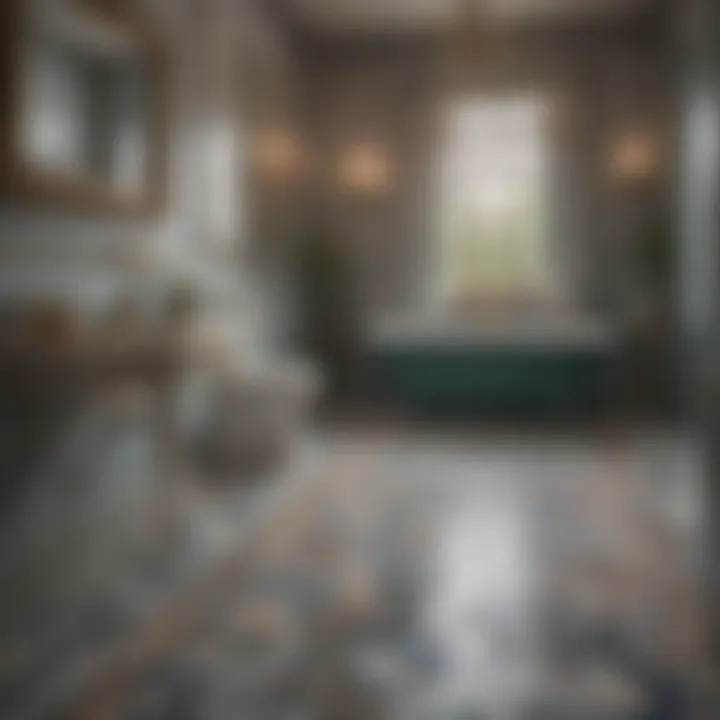
Spa-inspired Retreats
The concept of a spa-inspired bathroom has gained momentum. Homeowners increasingly seek to create a serene environment that mimics luxury spas. This transformation focuses on elements that promote relaxation. Features such as oversized soaking tubs, walk-in rain showers, and heated floors help achieve this ambiance. Natural materials like stone and wood enhance the calming effect.
Incorporating greenery can also create a soothing atmosphere. Plants such as ferns or peace lilies thrive in bathroom environments. Additionally, using ambient lighting can elevate the serenity of the space.
Minimalism and Open Spaces
Minimalism remains a hallmark in luxury design. It emphasizes space and simplicity, reducing clutter and distractions. A minimalist bathroom features clean lines, a restricted color palette, and an open layout. These characteristics foster a sense of openness and tranquility.
The removal of unnecessary items can lead to more practical spaces. For example, wall-mounted sinks not only increase floor space but also provide a modern look. Incorporating smart storage solutions ensures that functionality is not compromised. Utilizing open shelving adds an element of style while keeping essentials within reach.
Mixing Vintage and Modern Elements
An emerging trend is the juxtaposition of vintage and contemporary designs. This blend creates unique character and charm within the bathroom. Homeowners can achieve this by selecting modern fixtures paired with vintage-inspired details, like ornate mirrors or classic tile patterns.
Such combinations invite personalized expression while maintaining an upscale look. It allows one to showcase treasured artifacts alongside high-end contemporary pieces. The balance between old and new creates visual intrigue without overwhelming the senses.
In summary, embracing these trends enables the creation of luxury bathrooms that stand out in functionality and design. Each trend offers pathways to elevate personal space, catering to individual tastes and lifestyles.
Creating a Functional Bathroom Layout
A well-designed bathroom layout is essential for both the functionality and aesthetic appeal of the space. In luxury designer bathrooms, every square foot counts. The aim should be to create a balance between style and practicality, ensuring that the bathroom not only looks good but also meets the daily demands of its users.
Maximizing Space Efficiency
Efficient use of space is crucial in bathroom design. Small bathrooms can feel cramped if they are not organized properly. Here are some strategies to maximize space:
- Wall-mounted Vanities: These save floor space and create an illusion of a larger area.
- Corner Sinks: Utilizing corners can free up space and enhance movement.
- Compact Fixtures: Selecting smaller sinks, toilets, and bathtubs that maintain functionality without occupying too much room.
- Vertical Storage: Installing shelves or cabinets that extend upward can optimize storage without sacrificing area.
These techniques help create a layout that is practical while still offering an elegant design. Moreover, using mirrors effectively can amplify light and space perception, contributing significantly to a luxurious feel.
Considerations for Family and Guest Bathrooms
When designing bathrooms for families or guests, functionality must intertwine with comfort. It’s important to plan a layout that accommodates a variety of users. Consider these elements:
- Easy Accessibility: Ensure that the layout allows easy movement for all ages, including children and elderly.
- Durable Materials: Use materials that withstand heavy use. Options like porcelain tiles or quartz countertops are practical and stylish.
- Multiple Stations: For family bathrooms, having double sinks can alleviate morning rush hours. Separate bathing and grooming areas can also enhance functionality.
- Guest-Friendly Features: Include elements such as towel warmers or immediately accessible toiletries to enhance the guest experience.
A thoughtfully designed layout makes all the difference in luxury bathroom spaces. The emphasis should be on creating an environment that is harmonious, inviting, and tailored to the needs of its users.
Integrating Wellness into Bathroom Design
The modern bathroom is no longer simply a utilitarian space. It has evolved into a sanctuary for personal well-being. Integrating wellness into bathroom design is crucial for enhancing both physical and mental health. The bathroom can serve as a retreat from the stress and noise of daily life. By focusing on various elements such as relaxation features and sensory experiences, homeowners can elevate their bathroom spaces into holistic environments.
The importance of wellness in bathroom design lies in its capacity to foster relaxation and promote self-care practices. A well-considered bathroom can significantly improve the quality of one’s life. Key features like deep soaking tubs and heated floors can add comfort, while thoughtful layouts can facilitate a peaceful ambiance. Moreover, the inclusion of natural light through windows or skylights can positively influence mood and energy levels.
Incorporating Relaxation Features
When discussing relaxation features, the goal is to focus on elements that provide comfort and tranquility. A hot bath is often cited as a simple yet effective way to unwind after a long day. Bathing tubs can vary greatly. Freestanding tubs add a sense of luxury while the inbuilt types can save space.
Considerations for relaxation features include:
- Water temperature control: Adjustable thermostats can ensure the perfect water temperature.
- Massage jets: Features like whirlpool jets can provide a spa-like experience.
- Ambient lighting: Adjustable lighting can help create a calming atmosphere, encouraging relaxation.
Furthermore, integrating plants or natural elements can enhance the serene environment. A small indoor plant can purify the air and improve the mood.
Utilizing Aromatherapy and Sound Systems
Aromatherapy plays a significant role in creating a sensory experience in the bathroom. It involves using essential oils to stimulate the olfactory senses, which can affect mood and relaxation levels.
Essential oils can be diffused or added to bath water to enhance the bathing experience. For example:
- Lavender: Known for its calming properties, often used for stress relief.
- Eucalyptus: Helpful for respiratory issues and promotes invigoration.
- Peppermint: Provides an energizing effect that can be refreshing in the morning.
In addition, sound systems can be integrated into the bathroom to create an auditory ambiance.

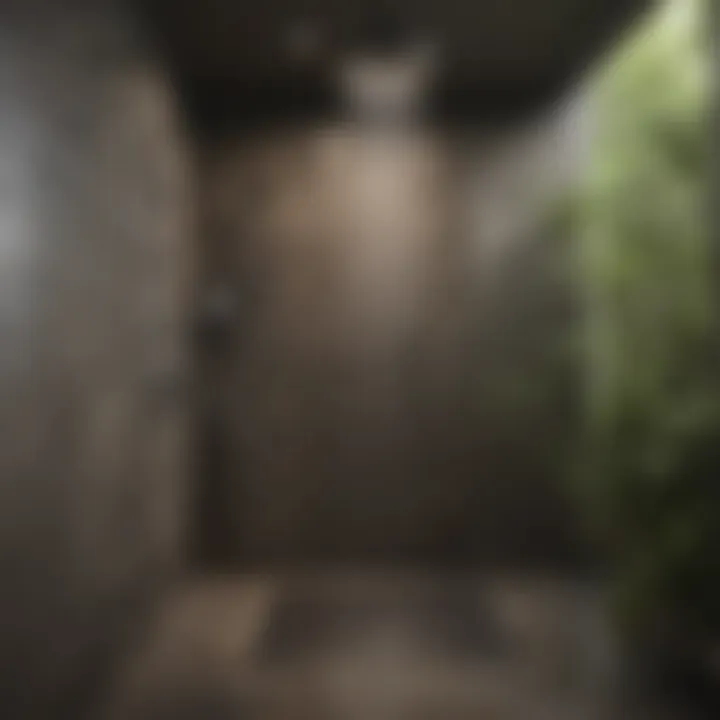
- Water sounds: The inclusion of a fountain can provide serene water sounds.
- Music: Playlists tailored for relaxation can improve the overall mood. Simple Bluetooth speakers can be part of the design without compromising aesthetics.
- Guided meditations: These can assist in creating a mental relaxation space.
The Role of Accessories and Decor
In the realm of luxury designer bathrooms, the role of accessories and decor cannot be overstated. These elements serve as the finishing touch, enhancing the overall aesthetic while also adding functional benefits. Accessories transform a sterile space into a personal sanctuary. They create a bridge between the bathroom’s core functionality and its potential for comfort and indulgence.
Choosing the right accessories entails careful consideration of various factors, including the bathroom's theme, size, and existing color palette. The selection must not only reflect personal style but also integrate seamlessly with the established design principles. Ultimately, this balance allows the bathroom to maintain its luxury status while also being inviting and practical.
Choosing Towels and Textiles
Towels and textiles play a pivotal role in the bathroom's overall ambiance. Quality towels contribute to both luxury and functionality. Opting for plush, high-thread-count cotton or bamboo towels enhances comfort and indulgence. Color and pattern choices also matter; subtle, neutral tones offer a calming atmosphere, while bold colors can serve as a statement feature.
When selecting textiles, one should think about how they complement other elements in the space. For instance, patterned curtains or bath mats can add visual interest. However, they should harmonize with the wall colors and fixtures to prevent a cluttered appearance.
- Consider these points when choosing textiles:
- Material: Select towels made from absorbent, durable materials.
- Color Coordination: Ensure that the colors align with the overall design theme.
- Texture Variety: Combine different textures to create a layered look.
Art and Decorative Items
The inclusion of art and decorative items solidifies the bathroom's character. These elements can reflect personal tastes and can be sourced from various styles, enhancing the overall luxury feel of the space. Artworks, sculptures, or even framed photographs can transform an ordinary bathroom into a curated space
When selecting art for bathrooms, consider the humidity and light conditions. Using water-resistant materials is essential for longevity. Incorporating decorative items such as elegant soap dispensers, artisanal vases, or carefully chosen candles yield both aesthetic appeal and practicality.
Some factors to keep in mind include:
- Scale and Proportion: Ensure items are appropriately sized for the space.
- Placement: Think about strategic placements that maximize visibility and impact.
- Simplicity: Sometimes, less is more; avoid overcrowding surfaces with decor.
"The right accessories can draw attention and create a cohesive look, elevating any bathroom to a sophisticated oasis."
Budget Considerations for Luxury Bathroom Projects
When undertaking a luxury bathroom project, budget considerations play a pivotal role in the overall success and satisfaction of the result. Understanding costs upfront helps to set realistic expectations and allows for informed decision-making throughout the design and renovation processes. This section provides essential insights into budgeting, enabling homeowners and design enthusiasts to achieve their dream bathrooms without financial distress.
Understanding Costs: What to Expect
The cost of a luxury bathroom can vary significantly based on several factors. Homeowners should be prepared for a wide range of expenses that include, but are not limited to:
- Materials: The selection of high-quality materials will impact costs. Natural stone such as marble or quartz, premium fixtures, and bespoke cabinetry typically come with higher price tags.
- Labor: Skilled labor is crucial in executing a luxury bathroom transformation. Hiring experienced contractors and designers can elevate the quality of work, but it also adds to the total costs.
- Design Fees: If utilizing the expertise of an interior designer, fees for their services must also be factored into the budget.
It is important to create a comprehensive list of all anticipated expenses and, ideally, to add an additional 10-15% for unexpected costs that may arise.
Finding Value in High-End Materials
Choosing high-end materials for a luxury bathroom project requires not just aesthetic considerations but also an evaluation of value. Quality materials ensure durability and longevity, which is essential for spaces regularly exposed to moisture and wear. When selecting materials, consider:
- Durability: High-quality finishes, such as porcelain tiles or solid wood vans, can withstand daily usage better than lower-tier alternatives.
- Maintenance: Some materials require more upkeep. For instance, natural stones can be prone to staining if not adequately sealed, so consider long-term maintenance needs in your selection process.
- Aesthetic Appeal: The right materials can enhance the visual presence of a bathroom. Investing in luxury adds not just to the immediate enjoyment but to the home’s overall value.
In summary, a well-planned budget, understanding associated costs, and selecting materials that provide value can result in a luxury bathroom that meets both functional and aesthetic needs. This careful financial planning ensures satisfaction with the end result without overspending or sacrificing quality.
Inspiration: Showcasing Luxury Bathroom Designs
Inspiration plays a crucial role in the design process, particularly when it comes to luxury bathrooms. This section is dedicated to providing insights that help homeowners and design enthusiasts visualize their ideal spa-like retreats. The visuals and ideas drawn from various sources can ignite creativity and provide a roadmap for personal style. Additionally, showcasing luxury bathroom designs allows for an exploration of not just aesthetic appeal, but also functionality and modern trends. The convergence of practicality and refinement is vital in today’s bathroom design.
Imbuing style into a personal space requires careful consideration. Inspirational designs exhibit elements such as:
- Unique layouts that optimize space
- A variety of materials and textures
- Innovative color palettes that set the mood
- Thoughtful lighting that enhances features
Overall, these elements together create a calming and luxurious atmosphere, transforming the bathroom into a personal sanctuary.
International Trends in Bathroom Design
Examining international trends in bathroom design reveals a rich tapestry of creativity. Different cultures impart their unique styles and approaches, influencing global design standards. For instance, the Japanese approach often emphasizes simplicity and natural materials, creating serene and minimalistic spaces. On the other hand, Scandinavian designs typically incorporate light colors and functional furniture that contribute to an airy ambiance.
Countries such as Italy and Spain are known for their opulent styles, marked by intricate tile work and grand fixtures. Homeowners can draw from these influences to create a space that not only caters to their taste but also tells a story through its materials and styling.
Real-life Examples and Case Studies
Real-life examples provide practical insights that can inspire new projects. Exploring case studies allows readers to see how others have successfully implemented luxury designs into their bathrooms. For instance, a small apartment renovation might showcase clever use of limited space, integrating a rain shower and storage solutions without feeling cramped.
Another example might involve a family’s transformation of an outdated bathroom into a modern oasis complete with a freestanding bathtub and sleek vanities. This real-world application of design principles illustrates the vast possibilities in luxury bathroom design.
Lastly, these examples highlight not only visual transformations but also the emotional impact spaces can create. Each case study serves as a reminder that luxury is not solely defined by price but rather by the experiences created within these reimagined spaces.







